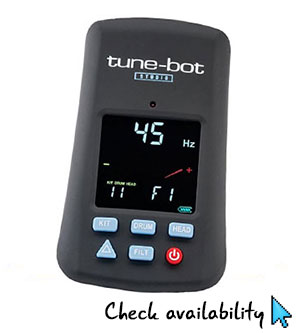

Once the drum is up to tension, tap around the drum about one inch from the counterhoop.

There are many schools of thought when it comes to fine-tuning, but I think mine is entirely accurate for tuning by ear. Retune the drums after you’ve broken them in.
BEST ACOUSTIC DRUM TUNER PRO
Pro tip: If you’re putting on new heads, I suggest cranking them up high and playing them for a few hours to allow the heads to stretch. If you’re unsure of which style to pick, aim for medium tension on each drum. Styles like jazz and hip-hop (with acoustic drums, that is) use higher-pitched drums, especially in the toms. Rock drums often are tuned lower, giving more punchy and deep tones.

Not only will you have a tuning goal in mind, but you’ll gain experience tuning to different styles. However, as a beginner, it is crucial to pick a style to aim for when tuning. I’ve heard of session drummers who tune an entire tension rod loose for the sound while working in the studio. It’s up to you to decide what type of tone you’d like. Be aware as you tune the drum up and as you practice, you’ll begin to compensate for the loss of tension on these rods. This phenomenon is perfectly normal you aren’t going mad. Please include attribution to with this graphic.Īs you move around the drum getting it to tension, you may notice that some tension rods become loose as you tighten others.
BEST ACOUSTIC DRUM TUNER CODE
Copy the code below and paste in raw HTML. Please use attribution: Info-graphic provided by.
BEST ACOUSTIC DRUM TUNER FREE
Feel free to tap the center of the drum to get an idea of the tone as you tune. Repeat this process until the head has low-to-medium tension. Begin your tuning at 6 o’clock and move up to 12 o’clock. I like to start at the bottom-most lug and move my way around tightening opposite tension rods.įor example, imagine an analog clock.

4) Tune the drum to low-to-medium tensionįind your drum key and turn each tension rod a half turn. Take this process slowly, as getting more even tension during this stage helps the tuning process as you go. Turn the rods until they are finger tight. Use your fingers and tighten each tension rod back into their respective lugs. Remembering where which tension rods fit, sit the counterhoop and rods back onto the drum. Take your new drum head and seat it on the bearing edge. For more helpful pointers, be sure to read my guide on drum maintenance. This step is optional, but give it a shot if you have some lying around. I usually also wipe a small amount of paraffin wax on the bearing edge to help the head sit better. The batter head (top) is more important to change than the resonant head (bottom), so you can wait longer to change the reso heads (once every few years for beginning drummers). Get used to this habit, as you’ll want to do this whenever you change your drum heads out (I recommend every three months). With both the top and bottom counterhoops removed, take a soft towel and wipe down the bearing edge and the inside of the shell (especially if you bought your kit used). The bearing edge is the sharp point where the drum shell meets the head. If your drum set is brand new, you can skip this step, but it’s still a good idea to get used to cleaning the bearing edge. 2) Clean and wax (optional) the bearing edge Remove the counterhoop with the tension rods still in the holes and set it next to the drum shell this is the easiest way I’ve found to keep them together. I feel it is better for the threads, allowing your hardware to last longer. Now, not everyone follows this, but I like to make sure that I keep the same tension rod paired with the same lug. Use two drum keys on lugs opposite of each other while removing the head. Pro tip: use two drum keys or the DW Drill Bit to remove drum heads faster. To remove the top and bottom drum heads, use the provided drum key to unscrew each tension rod on both sides of the drum. You may be thinking to yourself, “hey, the heads are already on the kit! Why should I remove them?” Well, in this situation since you are learning, it’s a good practice to remove both the heads to instill the techniques taught. Fine-tune the drum by lightly placing your index finger in the center of the head and tapping around the drum one inch from the rim.Work across the drum tightening the rod opposite to the one you’re on. Tighten each tension rod with your drum key a half turn.Fit a new head on the bearing edge and screw the tension rods back in with the counterhoop.Remove the top and bottom heads with your drum key.For more detail, be sure to read on after checking out each of these steps below. If you’re looking for a quick ‘n dirty approach to tuning a drum set, look no further. 4) Tune the drum to low-to-medium tension.2) Clean and wax (optional) the bearing edge.


 0 kommentar(er)
0 kommentar(er)
